Boost Your Greely Lawn: Fall Aeration Secrets Revealed
Quick Summary
- Fall is the optimal time for aerating Ottawa lawns, particularly in Greely where clay soil is common
- Core aeration relieves soil compaction, allowing air, water, and nutrients to reach grassroots
- The best window for fall aeration in Ottawa is late August through mid-October
- Core aeration (removing soil plugs) is more effective than spike aeration, especially for clay soils
- Combining aeration with overseeding and fall fertilizer creates optimal conditions for spring green-up
Introduction: Unlocking Your Greely Lawn’s Autumn Potential
Well hello there, Greely neighbours! It feels like another Ottawa summer has zipped by faster than a squirrel raiding your bird feeder, doesn’t it? The air’s getting crisp, the Senators are gearing up (we hope!), and those beautiful maple leaves are starting their technicolor transformation. While it’s tempting to just cozy up indoors and admire the autumn colours from afar, your lawn is actually sending out an S.O.S.
After a summer of backyard barbecues, maybe a few intense games of fetch, or simply enduring that Ottawa heat, the soil under your grass can get pretty packed down. Think of it like your lawn holding its breath! This compaction makes it tough for essential air, water, and nutrients to reach the roots.
But fear not! Autumn is the perfect time to give your lawn a helping hand before winter hibernation. One of the best things you can do right now is core aeration. Sounds fancy, but it’s basically giving your lawn spa treatment, allowing it to breathe easy and soak up goodness. Whether you’re right here in Greely, over in Manotick, or enjoying the peace in Osgoode, a little fall prep goes a long way towards ensuring a lush, green comeback next spring. Let’s dive into how you can set your lawn up for success!
What is Lawn Aeration, Anyway? (And Why Your Greely Lawn is Silently Screaming For It)
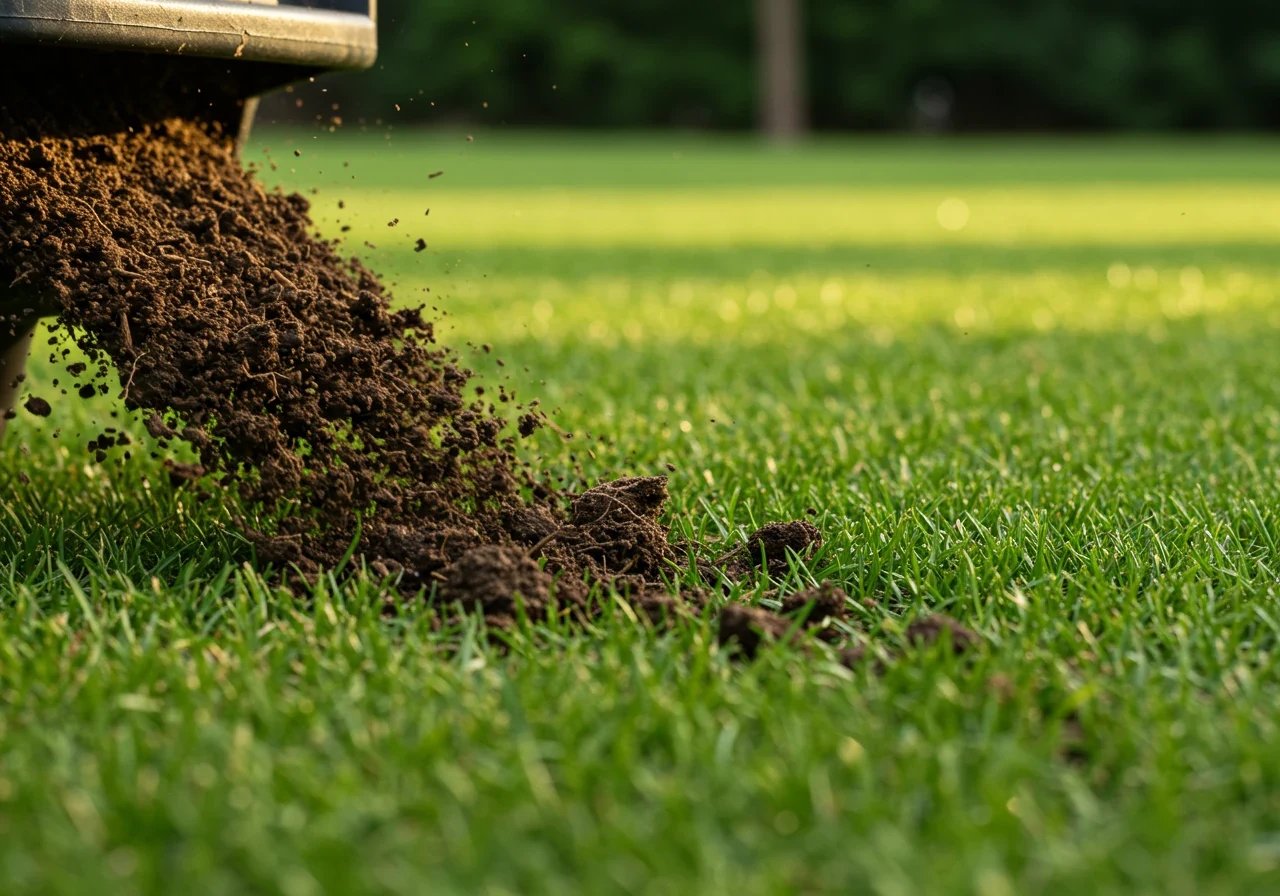
Okay, let’s talk aeration! You heard us mention it, maybe you’ve seen neighbours doing it, but what is this magical lawn treatment? Simply put, lawn aeration is the process of creating small holes in your lawn’s soil. Sounds basic, right? But the why is crucial, especially here in the Ottawa region.
The main villain we’re fighting is soil compaction. Imagine your soil particles like tiny building blocks. Over time, from foot traffic (kids, pets, backyard parties!), heavy lawnmowers, even just rain and natural settling, these particles get squished tightly together. This is especially true in areas with heavy clay soil, which is pretty common around Ottawa, from Greely right over to parts of Nepean and Barrhaven where new construction often involves heavy equipment.
When soil gets compacted, it’s like trying to breathe through a thick wool blanket. Air can’t get down to the grassroots. Water struggles to soak in, often pooling on the surface or running off (taking your precious topsoil with it!). And forget about fertilizer or essential nutrients reaching their target – they get stuck on the surface. Your lawn’s roots literally can’t breathe, drink, or eat properly. That’s why your lawn might be looking stressed, thin, or patchy, even if you’re watering and fertilizing. It’s silently suffocating!
Now, there are two main ways folks aerate:
- Spike Aeration: This involves poking solid spikes into the ground. Think of jabbing a fork into the lawn. While it seems helpful, it can sometimes make compaction worse around the edges of the hole. It’s generally less effective.
- Core (or Plug) Aeration: This is the good stuff! A core aerator uses hollow tines to pull out small plugs (cores) of soil and thatch, leaving them on the surface to break down naturally. This removes compacted soil, creating actual channels for air, water, and nutrients to penetrate deep down to the root zone.
So, what are the real-world benefits for your Greely lawn?
- Lets Your Lawn Breathe: Oxygen gets to the roots, promoting healthier growth.
- Improved Water Absorption: Water penetrates deeper, reducing runoff and making your watering efforts (and potentially your sprinkler system) more efficient. Less waste means happier wallets and a happier environment! If you’re seeing puddles or runoff, it might be time to check your setup; for related tips. More efficient watering is key everywhere, even comparing lawn needs to focused methods like .
- Better Nutrient Uptake: Fertilizer and organic matter can actually reach the roots where they’re needed most. Aeration creates the perfect surface prep if you’re considering adding beneficial organic matter; check out our guide on .
- Stronger Roots: With more room to grow and access to essentials, roots delve deeper, making your lawn more resilient to drought and stress. Healthy soil benefits everything growing in it, which is also key when considering things like these Richmond tree planting tips for healthy growth.
- Reduced Thatch Buildup: Those soil cores bring microorganisms to the surface that help break down excessive thatch (that layer of dead grass).
Core aeration is like hitting the reset button for your soil, giving your Greely lawn the breathing room it desperately needs to thrive. While you can rent aerators, it can be a bit of a workout. If tackling it yourself sounds daunting, exploring professional options might be the way to go – you can check out our lawn care services to see how we can help.
The ‘Why Fall?’ Files: Perfect Timing for Aeration in the Ottawa Valley
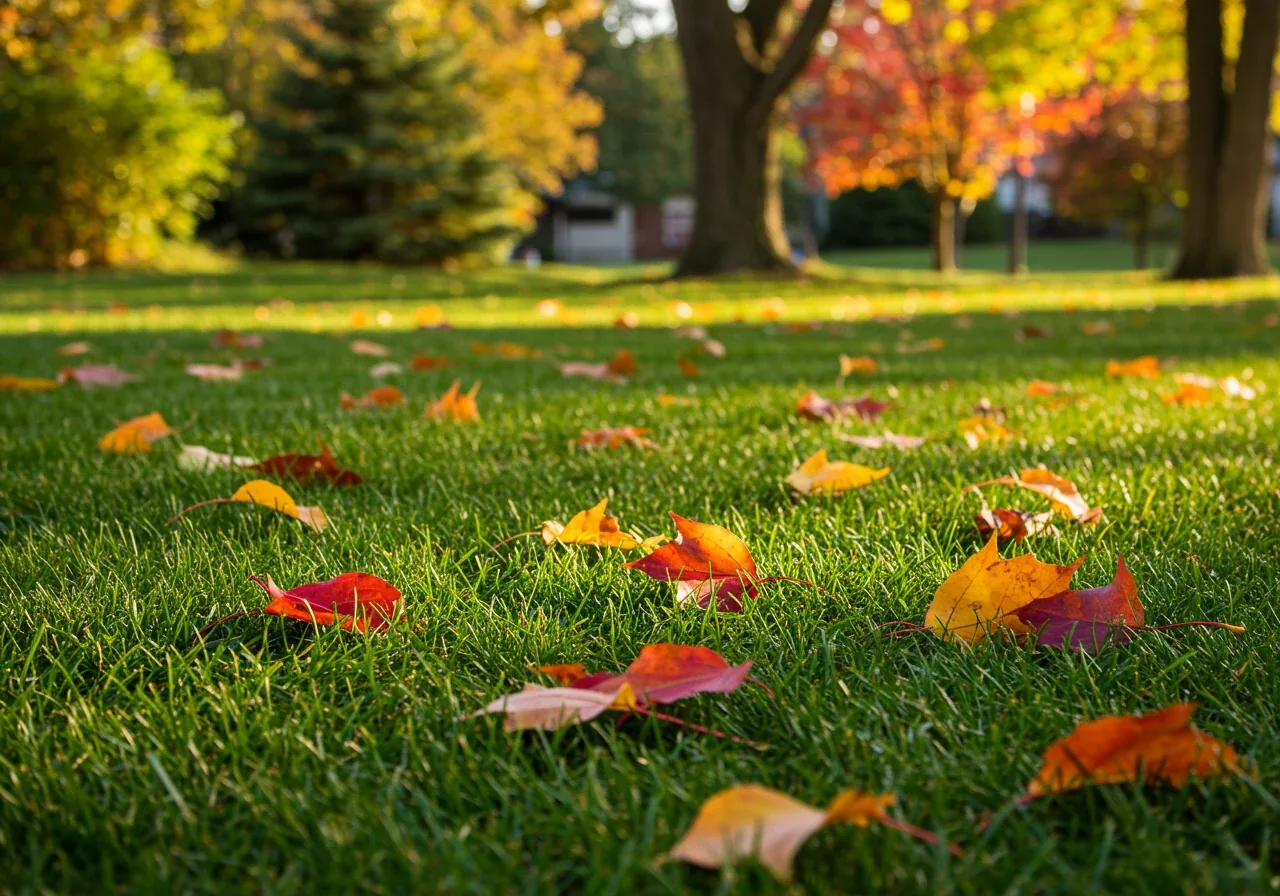
Alright, team lawn! Let’s chat about timing. You might be thinking, “Aeration sounds great, but why fall? Shouldn’t I do this in the spring when everything’s waking up?” It’s a fair question, almost as common as wondering why squirrels seem to have a personal vendetta against newly planted tulip bulbs. But trust us, for lawns here in the Ottawa Valley – from Greely and Metcalfe all the way out to Richmond – autumn is the VIP season for aeration.
Here’s the inside scoop: Most of our lawns are rocking cool-season grasses (think Kentucky bluegrass, fescues, ryegrass). These types have their main growth spurts in the spring and the fall. While spring is about lush top growth, fall is prime time for root development. It’s like the grass is bulking up underground before the big winter freeze.
Aerating in the fall works with this natural growth cycle. When you pull those soil plugs, you’re opening up pathways just as the roots are getting ready for their growth spurt. They can dive deeper, soaking up that crisp autumn air, rainwater, and any nutrients you provide (like fall fertilizer or overseeding). Speaking of overseeding, fall aeration creates the perfect little pockets for new grass seed to germinate safely. Choosing the right seed mix is crucial for success; learn more about smart landscaping material selection to make the best choice for your yard.
Think of it like this: Spring aeration can sometimes invite unwanted party crashers (hello, crabgrass!) because you’re opening up soil just as weed seeds are waking up too. Fall aeration avoids the main weed germination window.
Your Ottawa Fall Lawn Timing Cheat Sheet
- The Sweet Spot: Generally, late August through to mid-October is perfect. You want the soil to be moist enough for the aerator tines to penetrate easily, but not soggy. Air temperatures should be cool, reducing stress on the grass.
- Why This Window? It gives the grass several weeks of good growing weather to recover and establish stronger roots before the ground freezes solid.
Performing aeration now sets your lawn up for a glorious spring comeback. Stronger roots mean better winter survival and a quicker green-up when the snow finally melts (we know, let’s not rush that thought!). It reduces soil compaction accumulated over summer and helps water and nutrients get where they need to go, making your lawn more resilient overall.
Aeration is a key part of a comprehensive autumn routine. Consider pairing it with leaf removal and other preparations; combining services like aeration with a dedicated Greely garden clean-up service or broader Ottawa garden clean-up services ensures your entire yard is ready for winter.
While you can rent aerators, they can be hefty beasts to wrangle. If you’re considering professional help, you can explore our lawn and garden services to see how we can take the load off. Curious about the process or what past clients thought? Have a look at our customer estimate feedback page for insights into how we work. Give your lawn the fall advantage – it’ll thank you next spring!
Decoding Ottawa’s Dirt: Why Core Aeration is King for Clay Soil
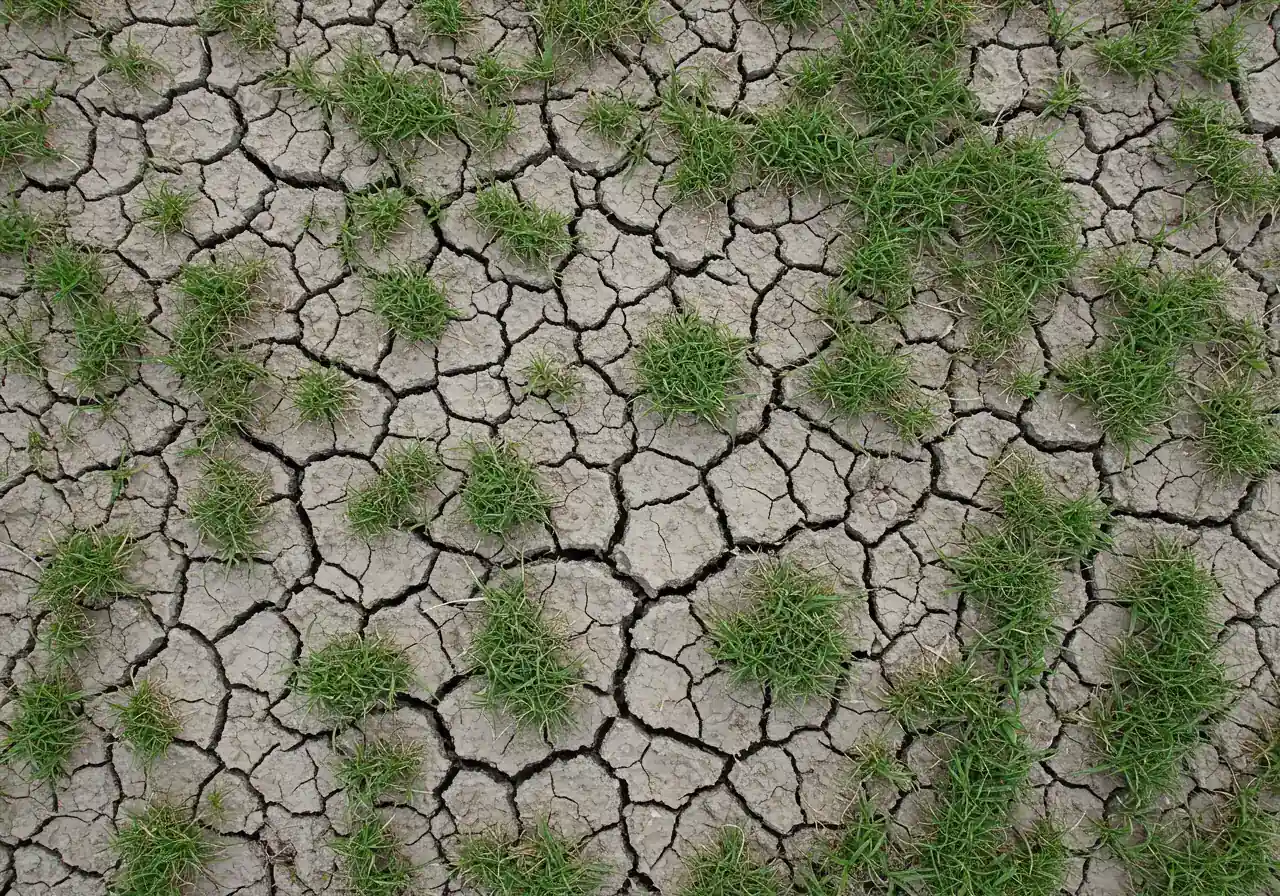
Ah, Ottawa soil. If you’ve ever tried digging a garden bed around here, especially in areas like Kars or older parts of Nepean, you know the struggle is real. We’re often blessed (or cursed, depending on your perspective!) with heavy clay soil. Think of it like the pottery clay you used in school – dense, sticky when wet, and hard as a rock when dry. While clay is rich in nutrients, its tiny, tightly packed particles are notorious for causing compaction.
Why is compaction such a villain for your lawn? Imagine trying to push a straw through packed clay – not easy, right? The same goes for air, water, and vital nutrients trying to reach your grassroots. Clay soil naturally resists easy penetration, and foot traffic, mowing, or even heavy rain just squishes those particles even closer together. This leads to poor drainage (hello, puddles!), shallow root growth, and stressed-out grass that struggles to thrive. On top of that, compacted clay can contribute to thatch buildup – that layer of dead grass stems and roots that can suffocate your lawn if it gets too thick.
So, what’s a homeowner with clay soil to do? Enter core aeration, the undisputed champion for tackling tough Ottawa dirt. Unlike spike aeration, which just pokes holes (and can sometimes make compaction worse around the hole in clay), core aeration uses hollow tines to physically pull out small plugs of soil and thatch.
This removal is key! It creates actual channels, breaking up the dense clay structure and allowing:
- Oxygen to reach the root zone.
- Water to soak in deeply instead of running off.
- Fertilizer and organic matter to get down where they’re needed.
- Roots to grow deeper and stronger.
The soil plugs left on the surface might look a bit messy initially, but they break down quickly, returning nutrients and beneficial microbes to your lawn, further helping to decompose thatch.
Core vs. Spike Aeration: The Clay Soil Showdown
Core aeration effectiveness ratings for Ottawa clay soils (based on industry research)
For Ottawa’s clay-dominant lawns, core aeration isn’t just helpful; it’s practically essential for long-term health. It directly counteracts clay’s tendency to compact. If you’re investing in improving your lawn, maybe even considering new sod installation in Ottawa, prepping the underlying clay soil properly with core aeration first is crucial for success. It’s a foundational step we, drawing on our experience highlighted on our Clean Yards About Us page, always recommend.
Dealing with core aeration can be a workout, especially on stubborn clay. Many homeowners opt for professional help. If you’re thinking about it, combining aeration with other fall tasks like leaf removal through an Ottawa yard cleanup service can be efficient. When requesting services or estimates, rest assured we value your privacy; you can review our detailed company privacy policy anytime. Wondering what others thought of the process? Check out our customer estimate feedback to see experiences shared by neighbours. Give your clay lawn the break it needs!
DIY vs. Done-For-You: Choosing Your Greely Aeration Adventure
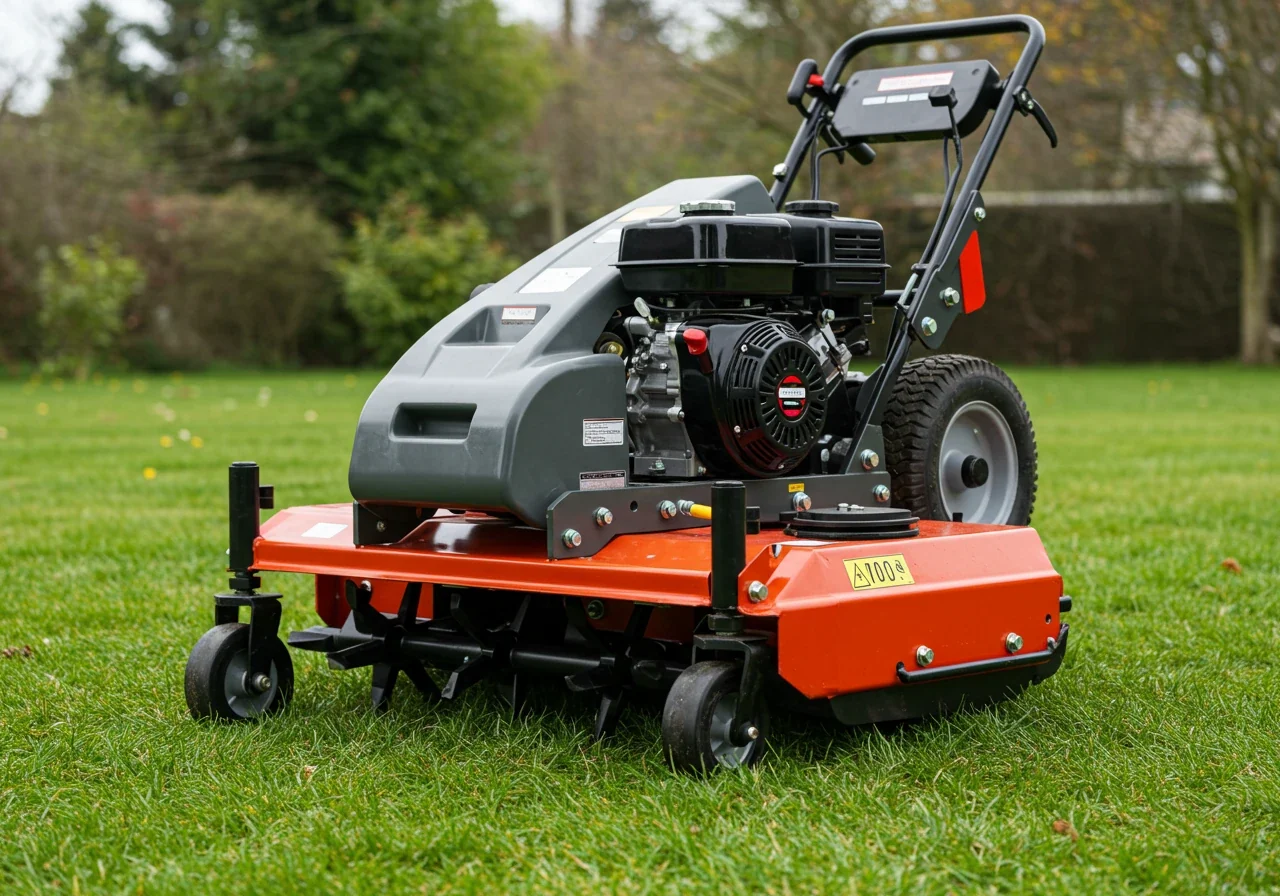
So, you’re convinced your Greely lawn needs to breathe easier. Fantastic! Now comes the big decision: do you roll up your sleeves and tackle aeration yourself, or call in the pros? It’s kind of like deciding whether to bake your own ridiculously complex sourdough bread or just grab a perfect loaf from the local bakery. Both have their merits! Let’s break down your options for this lawn care quest.
Aeration Methods Comparison
The DIY Route: The Thrifty Warrior
Pros:
- Potential Cost Savings: Renting an aerator for a few hours is usually cheaper upfront than hiring a service.
- Control & Timing: You do it exactly when you want, fitting it in between other activities.
- The Workout: Forget the gym! Maneuvering a core aerator is definitely physical exercise.
Cons:
- Equipment Challenges: Core aerators are heavy (100+ pounds) and bulky, requiring a suitable vehicle for transport.
- Learning Curve: Getting proper coverage without damaging your lawn takes skill.
- Hidden Costs: Factor in rental fees, fuel, your time, and possible equipment deposits.
- Safety Risks: Hitting underground sprinkler lines, invisible dog fences, or shallow utility lines can be costly.
The Done-For-You Route: The Convenient Connoisseur
Pros:
- Ease & Convenience: They show up, do the work efficiently, and leave. Your weekend remains free.
- Expertise & Equipment: Professionals have commercial-grade machines and know the optimal techniques.
- Efficiency: Pros can aerate even large properties quickly and thoroughly.
- Safety: Reputable companies are insured and know procedures for identifying underground hazards.
- Bundling Options: Often, you can combine aeration with other services for better value.
Cons:
- Cost: Hiring professionals typically costs more upfront than DIY.
- Scheduling: You’ll need to book in advance, especially during busy fall season.
Cost Breakdown Comparison
| Expense Factor | DIY Approach | Professional Service |
|---|---|---|
| Equipment | $80-150 rental fee (4-hour minimum typically) | Included |
| Transportation | Vehicle with appropriate capacity + fuel | Included |
| Time Value | 3-5 hours of your time | None (you’re free to do other things) |
| Risk & Insurance | Your responsibility for damages | Covered by company insurance |
| Typical Total | $100-200+ (not including your time) | $150-300 (varies by lawn size) |
Note: Values are approximate and may vary by location and lawn size. The smaller the cost difference, the more the convenience factor typically favors professional services.
Time Investment Comparison
The time required for aeration varies significantly based on your property size and approach:
DIY Time Breakdown
- Research & Planning: 1-2 hours
- Equipment Rental Process: 30-60 minutes
- Transport To/From Rental Location: 30-60 minutes
- Actual Aeration Process: 1-3 hours for average Greely property
- Equipment Cleaning & Return: 30-60 minutes
- Total Time Investment: 3.5-7.5 hours
Professional Service Time Breakdown
- Research & Booking: 15-30 minutes
- Brief Consultation Before Service: 5-10 minutes
- Your Presence During Service: Optional
- Total Time Investment: 20-40 minutes of your active time
The professional advantage becomes more pronounced with larger properties, where DIY time investment can increase substantially.
If you have a smaller lawn, enjoy physical yard work, are confident about avoiding underground lines, and have the time and transport, DIY can be rewarding.
However, for larger properties common in Greely and surrounding areas like Vernon or Russell, or if you simply value your time and want guaranteed results without the hassle and risk, hiring a professional is often the smarter, less back-breaking choice. Think of it as investing in your lawn and your weekend.
Ready to skip the heavy lifting? You can easily book an estimate online to see how affordable professional aeration can be for your Greely property. Check out our Google reviews to see what your neighbors think of our service!
The Fall Power Combo: Maximizing Aeration with Smart Lawn Care
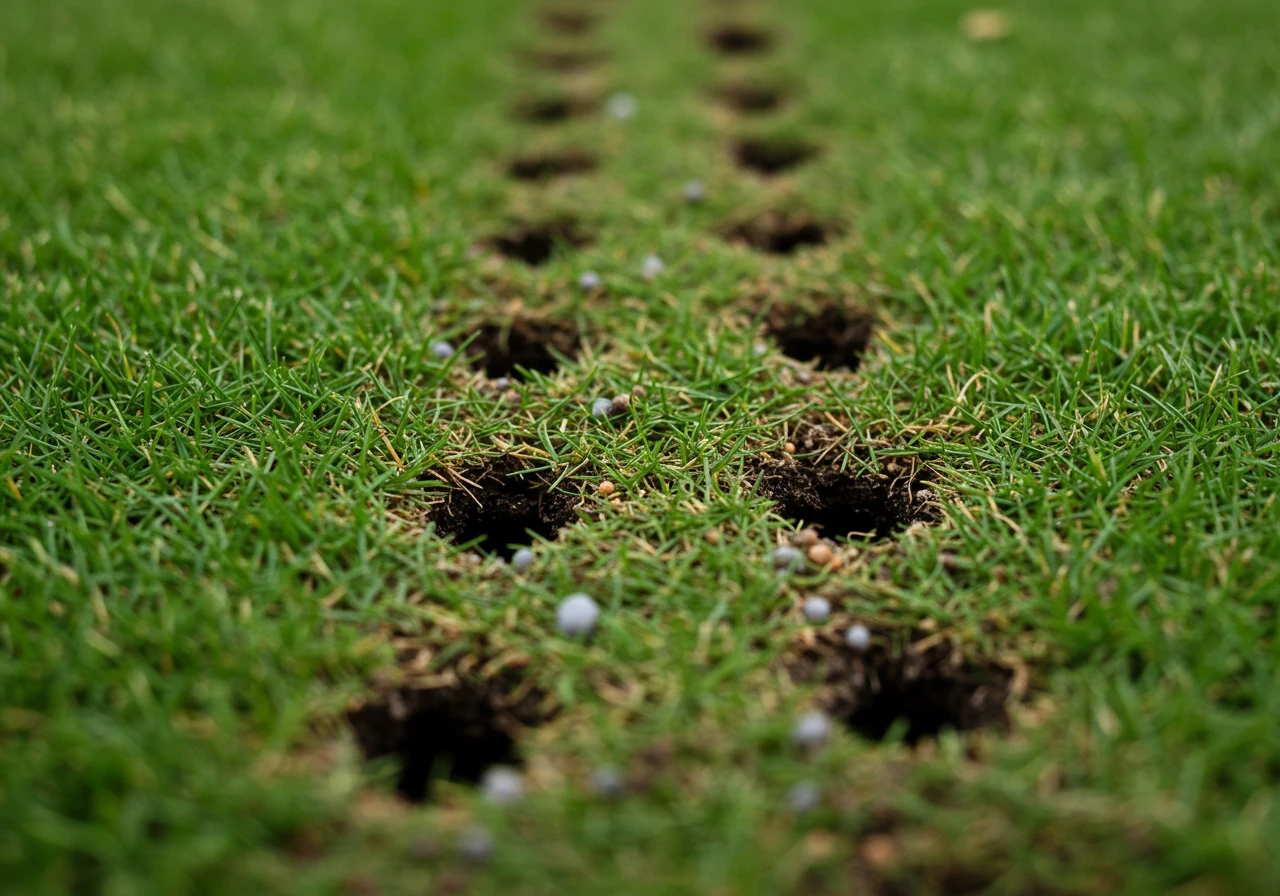
So, you’ve given your lawn the spa treatment with core aeration – awesome! Those little soil plugs are a sign of good things to come. But wait, don’t put your feet up just yet! Aeration is like opening the door; now’s the time to welcome in the good stuff. Combining aeration with a few other key fall lawn care steps creates a powerful synergy, a real dynamic duo (or trio, or quartet!) for turf success, setting the stage for a lush lawn next spring whether you’re in Embrun, Winchester, or right here in Ottawa.
Think of it this way: aeration creates opportunity, and these next steps capitalize on it.
The Perfect Post-Aeration Strategy
- Aeration + Overseeding = Perfect Planting Pockets: Those holes left by the aerator are prime real estate for new grass seed. Overseeding right after aeration provides excellent seed-to-soil contact, protecting the seeds and giving them a great start. Use a quality cool-season grass mix suitable for Ottawa’s climate (like blends with Kentucky bluegrass, fescues, and ryegrass). This thickens up thin areas, crowds out weeds naturally, and is a key step towards achieving significant lawn and landscape transformations.
- Aeration + Fall Fertilizer = Direct Root Delivery: Forget scattering fertilizer on compacted ground where much of it can just sit there or wash away. Aeration holes act like express lanes, delivering nutrients directly to the root zone where they’re needed most. Apply a “winterizer” or fall-specific fertilizer after aerating (and overseeding, if you’re doing that). Look for formulas lower in nitrogen and higher in potassium – potassium is crucial for root development, disease resistance, and winter hardiness. Your grass roots will thank you by growing stronger before the ground freezes.
The Seasonal Lawn Care Timeline for Ottawa
Early Spring (March-April)
Gentle rake to remove winter debris, apply pre-emergent if crabgrass has been an issue, first mowing when grass reaches 3 inches.
Late Spring (May-June)
First fertilizer application, regular mowing begins, spot-treat weeds as needed, ensure irrigation systems are working properly for the summer ahead.
Summer (July-August)
Raise mowing height to 3-3.5 inches, water deeply but infrequently during dry periods, watch for pest issues, avoid heavy treatments during heat stress.
Early Fall (September)
Core Aeration Season Begins! The ideal time to aerate, overseed, and apply fall fertilizer. Begin gradually lowering mowing height.
Mid-Fall (October)
Continue overseeding if needed, regular leaf removal to prevent lawn suffocation, second fall fertilizer application if recommended.
Late Fall (November)
Final mowing at 2-2.5 inches, complete leaf cleanup, winterizer fertilizer if not already applied, irrigation blowout before freezing.
Watering Wisdom: After aerating and especially after overseeding, consistent moisture is key. Those new seeds need water to germinate, and the existing grass needs it to recover and utilize the fertilizer. You don’t need to drown it, but water deeply enough to keep the top inch or so of soil consistently moist for the first couple of weeks, especially if Mother Nature isn’t cooperating with rainfall. If you’re unsure about the best watering schedule or setup for your lawn’s specific needs, it’s something easily discussed when you book a free lawn care estimate.
The Final Cut & Leaf Patrol: Don’t forget the leaves! Ideally, rake or blow leaves before you aerate and overseed. If they fall afterwards (as they inevitably do!), keep them off the newly seeded areas. A thick mat of leaves can smother new grass and promote disease. Consider mulching leaves with your mower if the layer isn’t too thick – it adds organic matter back to the soil. Then, give your lawn one final mow before winter, typically cutting it slightly lower than usual (around 2.5 inches), but not scalping it. A clean cut and tidy edges complement the work you’ve done; consider professional mulching and edging services for that crisp, finished look. For larger properties needing more extensive cleanup, like those needing a Marionville garden clean up service, tackling leaves is a major part of fall prep.
Combining these steps turns fall aeration from a single task into a comprehensive lawn renovation strategy. It’s also a great time to think about the bigger picture, perhaps planning improvements like a new border or feature; getting ideas for a potential new garden install now means you’re ready for spring. By working with your lawn’s natural fall growth cycle, you’re giving it everything it needs to survive winter and explode with green vigour next year.
Greely Aeration Quick Wins: Your Cheat Sheet
Okay, you’ve absorbed the ‘why’ and ‘when’ of aeration for your fabulous Greely property. Now, let’s cut to the chase with some quick, actionable tips – your personal cheat sheet for aeration success! Consider this the FAQ section where we tackle those lingering “Wait, but what about…?” questions.
We get it, fall flies by! Aim for that sweet spot between late August and mid-October here in the Ottawa area. You want the soil to be moist (like after a good rain, but not a swamp!), and the air temperatures nice and cool. This gives your grass roots time to recover and bulk up before the ground freezes solid, usually around or just after Thanksgiving.
Resist the urge to rake them up! Seriously, leave those little guys right where they are. They might look messy for a week or two, but they’re packed with beneficial microbes and nutrients. As they break down (mowing over them helps speed this up!), they return goodness to your lawn and help decompose thatch. If you’re already tidying up the whole yard, maybe with something like a thorough Marionville property cleanup service for leaves and debris, the plugs will break down naturally amidst that.
Great question! Definitely mow before you aerate. Cutting the grass to a normal height (don’t scalp it!) makes it easier for the aerator tines to penetrate the soil effectively and pull out cleaner plugs. It just makes the whole process smoother.
Play it safe here! Give your garden beds, tree roots, and any hardscaping edges a bit of breathing room – stay at least several inches away to avoid accidental damage from the machine. Aerating the lawn nearby does help the overall soil health, which indirectly benefits adjacent plantings. If looking near your beds gets you thinking about upgrades, now’s a good time to gather ideas for a potential beautiful new garden install next spring. Remember that healthy lawns and gardens go hand-in-hand; consistent upkeep via services focused on professional garden maintenance ensures everything looks its best.
Don’t leave those holes empty! The absolute best thing to do right after aeration is to overseed (especially thin areas) and apply a good fall fertilizer. Think of the aeration holes as little VIP entrances, getting seed and nutrients directly down to the root zone where they’ll do the most good. This combo is key for thickening the turf and preparing it for winter. You’ll see the amazing difference next spring – aiming for results like those lush spaces showcased in our project gallery.
Honestly, for the larger properties common in Greely and surrounding areas like Manotick or Osgoode, wrestling a heavy rental aerator can be a major chore (and potentially risky if you hit something underground). Unless you secretly love a serious physical challenge and have a truck handy, calling in professionals is often the faster, safer, and ultimately less stressful option. Your back will thank you!
FAQs: Your Greely & Ottawa Aeration Questions Answered
Got questions about giving your lawn the aeration treatment? You’re not alone! It’s a hot topic around Ottawa, especially when those leaves start turning. Here are some common questions we hear from neighbours in Greely, Metcalfe, and beyond, answered plain and simple.
Good thinking! You want the soil moist, but definitely not soggy. Think of trying to stick a fork into a slightly damp brownie – easy peasy! But try that with dry, crumbly soil or gooey batter, and it’s less effective. Ideally, aerate a day or two after a good soaking rain, or give your lawn a solid watering a day or two beforehand. This helps the aerator tines penetrate deeply and pull clean plugs without compacting wet soil or bouncing off hard ground. Proper moisture is a cornerstone of good soil preparation for any lawn care task.
Deep breaths! This is a super important concern. Before any aeration happens – whether you DIY or hire pros – it’s absolutely crucial to mark the locations of all sprinkler heads, valve boxes, shallow irrigation lines, and any buried wires like dog fences or landscape lighting cables. Most professional services (including us!) require this. Flagging them clearly helps avoid costly oops moments. Aerator tines typically penetrate about 2-3 inches, but hitting a shallow line is a real risk. If you have a complex system or are unsure where everything is, letting professionals handle it is the safest bet. Feel free to reach out to us via our contact page if you have specific worries about your property.
That’s fair! Not every lawn needs the VIP treatment annually. However, if your lawn gets a lot of action (think backyard parties, energetic pets, or kids practicing their soccer moves), or if you’re dealing with heavy clay soil common in many Ottawa areas, then yearly fall aeration is a fantastic investment in its health. You’ll also want to aerate annually if you notice water puddling after rain or the ground feels rock-hard. For mature, healthy lawns on good soil with less traffic, every 2-3 years might be perfectly fine. Watch your lawn – it’ll often tell you when it’s feeling suffocated!
Resist the urge to tidy up those soil plugs! Leave them right where they fall. They might look a bit untidy for a week or two, but they’re full of beneficial soil microbes that help break down thatch. They’ll crumble and disappear back into the lawn pretty quickly, especially with a few mows. As for leaves, it’s best to rake or mulch them before you aerate. If more leaves fall afterwards (which they usually do!), keep them off the lawn, particularly if you’ve also overseeded. A thick leaf blanket can smother new grass. It often makes sense to tackle aeration and leaf removal together; you might even bundle it as part of a complete Metcalfe property cleanup service to get everything sorted for winter.
It sure can help! Think of aeration as improving your lawn’s overall immune system. By reducing soil compaction, improving drainage, and increasing air circulation to the roots, you make the environment less welcoming for certain pests and fungal diseases that love damp, stagnant conditions. Specifically for snow mold (that nasty grey or pink fuzz that appears after snowmelt), reducing thatch and preventing soggy spots through aeration definitely helps minimize the risk. A healthy, breathing lawn is naturally more resilient. Keeping the yard clear of debris going into winter, maybe through a service like a thorough Marionville yard cleanup service, also removes places where pests and diseases might try to overwinter.
Conclusion: Give Your Greely Lawn the Green Light for Next Spring!
So there you have it, Greely neighbours! Your crash course in why fall aeration is basically a superhero cape for your lawn heading into the chilly Ottawa winter. We’ve dug into how breaking up that pesky soil compaction allows precious air, water, and nutrients to actually reach the roots. This essential fall lawn care step strengthens your grass before the snow flies, setting the stage for a much happier awakening. It’s the key difference between a lawn that limps into spring looking tired and one that bursts out of the gate, lush and ready to impress. Think of it as giving your turf the ultimate pep talk (and some much-needed breathing room!).
Don’t let your lawn face another winter feeling squeezed and gasping for air! A little effort now pays off big time with a healthier, greener carpet of grass next year. Ready to skip the workout of wrestling a heavy aerator and ensure the job gets done right? Let us help give your Greely lawn the green light for a fantastic spring comeback. We love helping homeowners achieve beautiful results across the region, including Manotick, Metcalfe, and Kenmore.
For more lawn care tips and comprehensive property maintenance services, don’t forget to explore our dedicated lawn care and property clean-up service pages. If you’re in the Metcalfe area and looking for similar services, we also offer specialized Metcalfe yard cleanup services.
If you’ve enjoyed working with us, we would appreciate your feedback on our thank you page. And remember, all our services are provided according to our terms and conditions.


